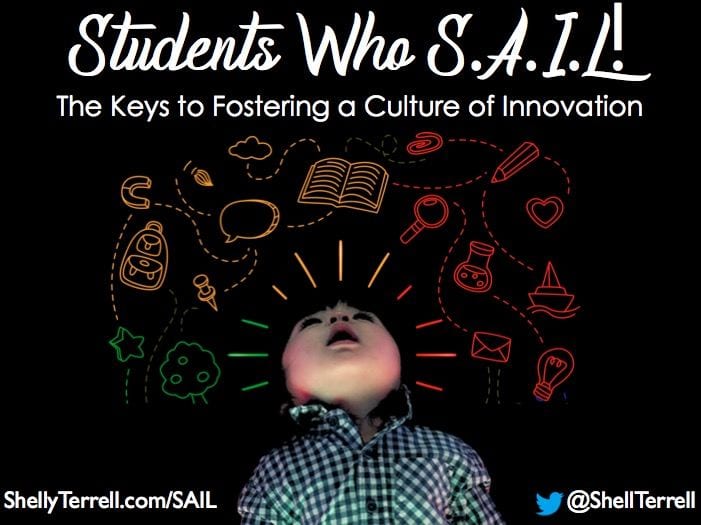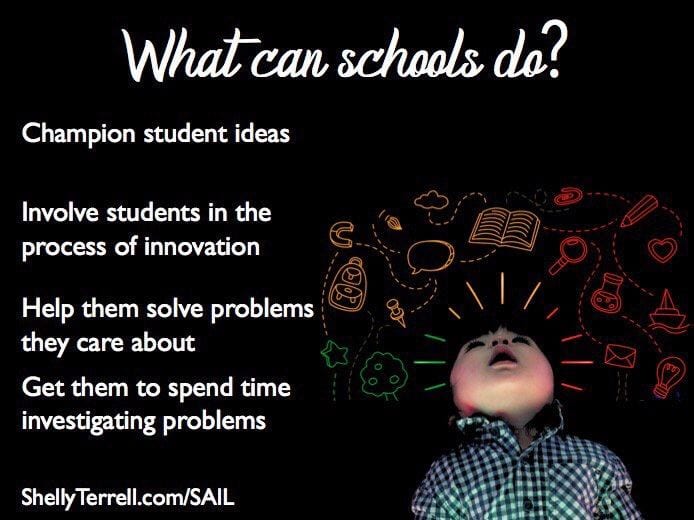 Yesterday, I presented a new keynote for the NJAIS Innovation Symposium, The Keys to Fostering a Culture of Innovation! Students who S.A.I.L. The purpose was to help teachers facilitate and inspire student innovation. As I prepared for my keynote, I had to think about how teachers who perhaps didn’t define themselves as “innovators” might go about inspiring students to be innovative. First, I defined innovation as finding solutions to problems. Then, I propose that the main role of schools, who want to foster a culture of innovation, is to focus less on getting students to come up with “solutions,” and instead to focus on ideation and the problem-solving process. The role of schools should be to accomplish the following- champion student ideas, frequently involve students in the process of innovation, help students think of solutions for problems they care about or impact them, and get students to spend time researching and investigating problems, failures, and solutions.
Yesterday, I presented a new keynote for the NJAIS Innovation Symposium, The Keys to Fostering a Culture of Innovation! Students who S.A.I.L. The purpose was to help teachers facilitate and inspire student innovation. As I prepared for my keynote, I had to think about how teachers who perhaps didn’t define themselves as “innovators” might go about inspiring students to be innovative. First, I defined innovation as finding solutions to problems. Then, I propose that the main role of schools, who want to foster a culture of innovation, is to focus less on getting students to come up with “solutions,” and instead to focus on ideation and the problem-solving process. The role of schools should be to accomplish the following- champion student ideas, frequently involve students in the process of innovation, help students think of solutions for problems they care about or impact them, and get students to spend time researching and investigating problems, failures, and solutions.
If you like these ideas, take one of my courses or check out my books. Ask me about training your teachers, ShellyTerrell@gmail.com!

9,999 Failed Solutions?
I’ll be blogging about each of the steps of the process for harnessing student innovation in the weeks to come, but first let me explain why I believe we shouldn’t focus so much on finding the right solutions. If you’ve read the biographies of the world’s most profound innovators, then you realize that they had several prototypes or designs that didn’t work before they came up with the ideal solution/product/prototype/design. Think about our mobile devices and technology now. Most people know that if you are one of the first to get the latest gadget, chances are you will need to get an update or the next versions, because the first model always has bugs. Innovation isn’t a one day or week or month endeavor. Innovation tends to be years of investment and for the very passionate, a lifetime endeavor. Let’s take Thomas Edison as an example who had over 1000 U.S. patents. Before he came up with the working light bulb, he was reported to have 5,000 to 10,000 failed prototypes. You also read how many innovators struggled in school. Back then schools didn’t have makerspaces, genius hour, or curricula that supported invention and innovation. Imagine, though, if Edison had been able to test out his ideas and 5,000 light bulb prototypes throughout his schooling. How much more would Edison, Einstein, and other innovators have accomplished by receiving the guidance to attempt solving a solution several times (S.A.I.L.)?
Students will come up with solutions as part of the process or problem-solving. Ideally, students should come up with hundreds of solutions and get the opportunity to test them out before they graduate. The more schools get students involved in coming up with solutions and investigating real world problems, the more opportunities they learn from the solutions that don’t work and come up with the ones that eventually do work. Read more about S.A.I.L in upcoming posts here. Below are the slides to my keynote.
You also read how many innovators struggled in school. Back then schools didn’t have makerspaces, genius hour, or curricula that supported invention and innovation. Imagine, though, if Edison had been able to test out his ideas and 5,000 light bulb prototypes throughout his schooling. How much more would Edison, Einstein, and other innovators have accomplished by receiving the guidance to attempt solving a solution several times (S.A.I.L.)?
Students will come up with solutions as part of the process or problem-solving. Ideally, students should come up with hundreds of solutions and get the opportunity to test them out before they graduate. The more schools get students involved in coming up with solutions and investigating real world problems, the more opportunities they learn from the solutions that don’t work and come up with the ones that eventually do work. Read more about S.A.I.L in upcoming posts here. Below are the slides to my keynote.
If you like these ideas, take one of my courses or check out my books. Ask me about training your teachers, ShellyTerrell@gmail.com!
The Culture of Innovation! Teaching Students to SAIL from Shelly Sanchez Terrell Challenge: Does your curriculum support student innovation? What are ways you can tweak it to support students spending time investigating problems and brainstorming many ways to improve the situation?Subscribe for FREE to receive regular updates!
?Get your copy of Hacking Digital Learning or The 30 Goals Challenge or take a fully accredited online course for graduate credit (Online Learning Best Practices, Connected Educators or TESOL Methodologies)!






